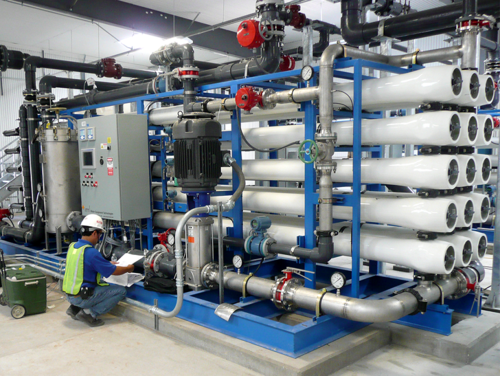Why PFAS Treatment Is Crucial for Reducing Harmful Chemical Exposure
Why PFAS Treatment Is Crucial for Reducing Harmful Chemical Exposure
Blog Article
Your Overview to PFAS Treatment Technologies and Conveniences
The prevalence of PFAS contamination in water resources requires a thorough understanding of offered treatment modern technologies. Each technology not just targets certain PFAS substances yet additionally plays an essential function in enhancing total water top quality and securing environmental stability.
Recognizing PFAS Contamination
Recognizing PFAS contamination is critical for resolving its prevalent influence on ecological and human wellness (m270 pfas treatment). Per- and polyfluoroalkyl substances (PFAS) are a group of synthetic chemicals widely used in various commercial and consumer items due to their water- and grease-resistant residential properties. Frequently discovered in firefighting foams, non-stick cooking equipment, and water-repellent textiles, PFAS have gotten in the setting with production processes, wastewater discharges, and leaching from garbage dumps
Once launched, these materials persist in the atmosphere, causing extensive contamination of dirt and water sources. Their special chemical framework, characterized by solid carbon-fluorine bonds, provides them resistant to destruction, causing a phenomenon understood as "forever chemicals." PFAS can gather in the human body and the food chain, potentially creating negative health results, consisting of immune system disruption, developing issues, and a raised risk of specific cancers.
Regulative firms and wellness organizations are increasingly identifying the relevance of PFAS contamination, prompting initiatives to keep an eye on, analyze, and reduce its results. Recognizing the pathways of PFAS contamination is necessary for educating public plan and establishing efficient techniques to protect both ecological and human health and wellness.
Review of Therapy Technologies
Various treatment innovations have actually been established to resolve the challenges postured by PFAS contamination in water and soil. These modern technologies can be generally categorized into a number of categories, each with its distinct systems and performance in eliminating PFAS compounds.
One famous method is ion exchange, which uses material materials to capture and get rid of PFAS from contaminated water. This method is especially effective for short-chain PFAS and can attain significant decreases in concentration degrees. An additional technology, advanced oxidation processes (AOPs), utilizes solid oxidants and ultraviolet light to damage down PFAS right into much less dangerous materials. AOPs appropriate for dealing with a variety of PFAS substances however may require careful optimization to take full advantage of effectiveness.

Turned On Carbon Filtration
Activated carbon filtering is an extensively used method for the elimination of PFAS from contaminated water, recognized for its capability to adsorb a broad variety of organic substances. This modern technology uses activated carbon, a very permeable material with a comprehensive area, which promotes the binding of PFAS molecules via physical adsorption. The efficiency of triggered carbon in removing PFAS is influenced by numerous informative post variables, consisting of the type of carbon used, the get in touch with time, and the concentration of PFAS in the water.
Among the benefits of turned on carbon filtering is its flexibility; it can be executed in numerous arrangements, such as granular triggered carbon (GAC) systems or powdered turned on carbon (POLITICAL ACTION COMMITTEE) systems. GAC systems are usually used in larger-scale applications, while political action committee can be utilized in smaller or temporary configurations. The modern technology is reasonably easy to run and keep, making it obtainable for several water therapy centers.

Ion Exchange Systems
Ion exchange systems represent one more reliable technique for the removal of PFAS from contaminated water, complementing techniques like triggered carbon filtration. These systems operate on the concept of exchanging ions in the water with ions hung on a resin material. Ion exchange materials can be particularly developed to target the adversely billed PFAS substances, effectively capturing them and permitting cleaner water to pass through.
Among the main benefits of ion exchange systems is their capacity to eliminate a variety of PFAS, consisting of both long-chain and short-chain variations. This flexibility makes them ideal for numerous applications, varying from community water therapy to commercial procedures. Furthermore, ion exchange systems can commonly accomplish reduced detection limitations for PFAS contrasted to some other treatment techniques, therefore enhancing water top quality.
Nonetheless, it is vital to keep track of and manage the regrowth of ion exchange media, as the performance can decline gradually as a result of saturation. Appropriate maintenance and substitute of the material are crucial for maintaining the system's effectiveness. In general, ion exchange systems supply a dependable and effective solution for PFAS removal, contributing significantly to secure alcohol consumption water criteria and environmental defense.
Advanced Oxidation Processes
Advanced Oxidation Processes (AOPs) use powerful oxidants to efficiently weaken PFAS compounds in contaminated water. These innovative treatment methods create highly responsive species, such as hydroxyl radicals, that can damage down complex PFAS molecules right into less damaging results. m270 pfas treatment. AOPs generally employ combinations of ultraviolet (UV) light, ozone, hydrogen peroxide, or Fenton's reagent, boosting the oxidation potential and enhancing destruction effectiveness
The main benefit of AOPs exists in their straight from the source ability to target a broad series of PFAS compounds, consisting of both long-chain and short-chain versions. This flexibility is essential, as PFAS contamination often entails mixes of various substances with varying chemical structures. Moreover, AOPs can be incorporated into existing water therapy systems, making them a useful service for lots of districts and industries.
Nonetheless, the application of AOPs can be resource-intensive, requiring careful factor to consider of operational expenses and energy intake. Additionally, while AOPs are reliable in damaging down PFAS, they might not totally eliminate all by-products, necessitating further treatment actions - m270 pfas treatment. Overall, AOPs stand for an appealing method for attending to PFAS contamination, adding to cleaner water sources and enhanced public health and wellness security

Final Thought
By selecting the appropriate technology, areas can boost water high quality, secure public wellness, and alleviate the environmental dangers connected with PFAS exposure. Proceeded research and application of these methods are important for effective monitoring of PFAS contamination in impacted areas.
Report this page